Scattering of Radiation by a Periodic Structure of Circular and Elliptical Microcavities in a Multimode Optical Waveguide
Abstract
1. Introduction
- Medical diagnostics and surgery—creation of special probes for operations requiring additional lighting and uniform irradiation of affected areas. For practical application of radiation scattered on a periodic structure, it is crucial to ensure maximum power distribution uniformity along the optical fibre length. For this purpose, optimal geometric parameters of the microstructure were determined [13,14,15]. The impact of emitting microcavities with various scattering intensity profiles on living tissues was investigated by Strobl et al. [16,17].
- Optical sensors—development of sensitive elements for fibre-optic sensors. Each microcavity functions as a Fabry–Pérot micro interferometer; consequently, a periodic microcavity structure represents a system of coupled and interacting Fabry–Pérot micro interferometers. When coherent radiation passes through such a structure, multiband interference occurs, with the interference pattern depending on external influences [15,18,19]. This property can be applied for sensor creation. In areas of maximum radiation reflection, power increases, which may further enhance the sensor quality factor. The existing studies in this field [20,21,22,23] are mainly focused on the research of Bragg gratings and their application in fibre-optic sensors.
- Radiation diffusers—uniform distribution of light flux in various diagnostic devices.
2. Problem Statement and Numerical Methods
2.1. Problem Statement
2.2. Numerical Calculation Methodology
3. Results
4. Discussion
5. Conclusions
- Microcavity diameter of d = 3.6–4.4 μm or d = 7.5–8.0 μm, with a fixed period of T = 12.76 μm;
- Microcavity period of T = 30.0–37.0 μm, with a fixed diameter of d = 5.15 μm.
- Microcavity diameter of d = 5.0–6.6 μm, with a fixed length of l = 19.18 μm and a period of T = 25.51 μm;
- Microcavity length of l = 10–12 μm, with a fixed diameter of d = 5.15 μm and a period of T = 25.51 μm;
- Microcavity period of T = 19.18–32 μm, with a fixed length of l = 19.18 μm and a diameter of d = 5.15 μm.
Author Contributions
Funding
Institutional Review Board Statement
Informed Consent Statement
Data Availability Statement
Conflicts of Interest
Abbreviations
| PEC | perfect electric conductor |
| PML | perfectly matched layer |
References
- Todoroki, S. Origin of periodic void formation during fiber fuse. Opt. Express 2005, 13, 6381–6389. [Google Scholar] [CrossRef] [PubMed]
- Todoroki, S. In-situ observation of fiber-fuse propagation. Jpn. J. Appl. Phys. 2005, 44, 4022–4024. [Google Scholar] [CrossRef]
- Todoroki, S. Transient propagation mode of fiber fuse leaving no voids. Opt. Express 2005, 13, 9248–9256. [Google Scholar] [CrossRef] [PubMed]
- Shuto, Y. Fiber Fuse Phenomenon, 3rd ed.; Design Egg, Inc.: Osaka, Japan, 2021; p. 370. ISBN 978-4-8150-1631-9. [Google Scholar]
- Shuto, Y. Cavity pattern formation and its dynamics of fiber fuse in single-mode optical fibers. J. Inform. Math. Sci. 2020, 12, 271–288. [Google Scholar] [CrossRef]
- Shuto, Y.; Yanagi, S.; Asakawa, S.; Kobayashi, M.; Nagase, R. Fiber fuse phenomenon in step-index single-mode optical fibers. IEEE J. Quantum Electron. 2004, 40, 1113–1121. [Google Scholar] [CrossRef]
- Konin, Y.A.; Scherbakova, V.A.; Perminov, A.V.; Petukhova, A.Y. Study of micro-cavities formed by optical breakdown under the influence of a magnetic field. Opt. Commun. 2022, 517, 128242. [Google Scholar] [CrossRef]
- Konin, Y.A.; Scherbakova, V.A.; Bulatov, M.I.; Malkov, N.A.; Lucenko, A.S.; Starikov, S.S.; Grachev, N.A.; Perminov, A.V.; Petrov, A.A. Structural characteristics of internal microcavities produced in optical fiber via the fuse effect. J. Opt. Tech. 2021, 88, 672–677. [Google Scholar] [CrossRef]
- Starikova, V.A.; Petukhova, A.Y.; Konin, Y.A.; Perminov, A.V. Plasma spark formation during optical breakdown of an optical fiber. Foton-Express 2023, 6, 396–397. (In Russian) [Google Scholar] [CrossRef]
- Konin, Y.A.; Starikova, V.A.; Petukhova, A.Y.; Grachev, N.A.; Petrov, A.A.; Perminov, A.V. Mathematical model of radiation scattering on a quasi–periodic structure in an optical fiber. Appl. Photonics 2023, 10, 42–55. [Google Scholar] [CrossRef]
- Petukhova, A.Y.; Konin, Y.A.; Perminov, A.V. Obtaining a scattering structure by the method of optical breakdown in special fibers. Appl. Photonics 2023, 9, 26–53. [Google Scholar] [CrossRef] [PubMed]
- Petukhova, A.Y.; Perminov, A.V.; Starikova, V.A.; Konin, Y.A. Mathematical model of radiation scattering on quasi-periodic microstructure in optical fiber. Bull. Russ. Acad. Sci. Phys. 2024, 88, 1000–1009. [Google Scholar] [CrossRef]
- Konin, Y.A.; Bulatov, M.I.; Scherbakova, V.A.; Garanin, A.I.; Tokareva, Y.D.; Mosheva, E.V. Investigation of the properties of the tsssno-volokonnyi temperature sensor created by the melting effect. Instrum. Tech. Exp. 2020, 4, 7882. [Google Scholar] [CrossRef]
- Konin, Y.A.; Shcherbakova, V.A.; Garanin, A.I.; Mosheva, E.W.; Grachev, N.A. The Development of All-fiber Temperature Sensor for Extreme Conditions. In Proceedings of the 2021 IEEE Conference of Russian Young Researchers in Electrical and Electronic Engineering (ElConRus), Moscow, Russia, 26–29 January 2021; IEEE: Piscataway, NJ, USA, 2021; pp. 1317–1320. [Google Scholar] [CrossRef]
- Konin, Y.A.; Garanin, A.I.; Scherbakova, V.A. Research the thermal sensitivity of a fiber optic sensor created with the catastrophic fuse. In Proceedings of the 2019 IEEE Conference of Russian Young Researchers in Electrical and Electronic Engineering (EIConRus), Moscow, Russia, 28–31 January 2019; Volume 32, pp. 90–104. [Google Scholar] [CrossRef]
- Ströbl, S.; Domke, M.; Rühm, A.; Sroka, R. Investigation of non-uniformly emitting optical fiber diffusers on the light distribution in tissue. Biomed. Opt. Express 2020, 11, 3601–3617. [Google Scholar] [CrossRef] [PubMed]
- Ströbl, S.; Wäger, F.; Domke, M.; Rühm, A.; Sroka, R. Homogeneously emitting, mechanically stable and efficient fs-laser machined fibre diffusers for medical applications. Lasers Surg. Med. 2020, 54, 588–599. [Google Scholar] [CrossRef] [PubMed]
- Konin, Y.A.; Petrov, A.A.; Starikova, V.A.; Smolnikov, A.G. Wide temperature range fiber optic sensor. Bull. Russ. Acad. Sci. Phys. 2022, 86, 100–103. [Google Scholar] [CrossRef]
- Konin, Y.A.; Petrov, A.A.; Perminov, A.V.; Petukhova, A.Y.; Smolnikov, A.G.; Lucenko, A.S.; Trushnikov, V.S. Fiber optic sensor for cryogenic liquids. Bull. Russ. Acad. Sci. Phys. 2024, 88, 983–985. [Google Scholar] [CrossRef]
- Nuerev, I.I. Modeling of spectral characteristics of fiber Bragg gratings with phase shift for solving problems of optomechanics in sensor systems. Inf. Technol. Radioelectron. Telecommun. 2015, 5, 127–133. [Google Scholar]
- Safaryan, K.A.; Goldobin, A.A.; Trefilov, I.A.; Goncharov, M.M. Modeling of a fiber-optic vibration sensor based on a fixed Bragg grating. Appl. Photonics 2024, 11, 123–135. [Google Scholar] [CrossRef]
- Matveenko, V.P.; Serovaev, G.S.; Kosheleva, N.A. Results of mathematical modeling supporting the reasonable use of fiber-optic strain sensors based on Bragg gratings. In Proceedings of the XII All-Russian Congress on Fundamental Problems of Theoretical and Applied Mechanics, Ufa, Russia, 19–24 August 2019; Volume 3, pp. 1333–1335. [Google Scholar]
- Zakharov, V.N. Modeling of fiber-optic sensors for electrical quantities based on Bragg gratings with instrumental error correction. In Proceedings of the ITNT-2019. New Technology, Samara, Russia, 21–24 May 2019; Volume 1, pp. 499–504. [Google Scholar]
- Kashaganova, G.B.; Amirgalieva, S.N.; Kalizhanova, A.U.; Kartbaev, T.C.; Kozbakova, A.X. Numerical modeling of a fiber Bragg grating in MATLAB environment. In Proceedings of the International Symposium “Reliability and Quality”, Penza, Russia, 21–31 May 2018; Volume 1, pp. 329–333. [Google Scholar]
- Glushkov, E.V.; Glushkova, N.V.; Evdokimov, A.A. Hybrid numerical-analytical scheme for calculating elastic wave diffraction in locally inhomogeneous waveguides. Acoust. Phys. 2018, 64, 1–9. [Google Scholar] [CrossRef]
- Yamada, M.; Kinoshita, T.; Kimura, Y.; Koyama, O.; Sato, N. Scattering characteristic of light generating an optical fiber fuse. In Proceedings of the 2014 OptoElectronics and Communication Conference and Australian Conference on Optical Fibre Technology, Melbourne, Australia, 6–10 July 2014; pp. 179–180. [Google Scholar]
- Korsakova, E.A.; Lvov, A.E.; Kashuba, I.A.; Korsakov, V.S.; Salimgareev, D.D.; Korsakov, A.S.; Zhukova, L.V. Fiber-optic assemblies based on polycrystalline lightguides for the mid-IR. J. Opt. Tech. 2019, 86, 439–445. [Google Scholar] [CrossRef]
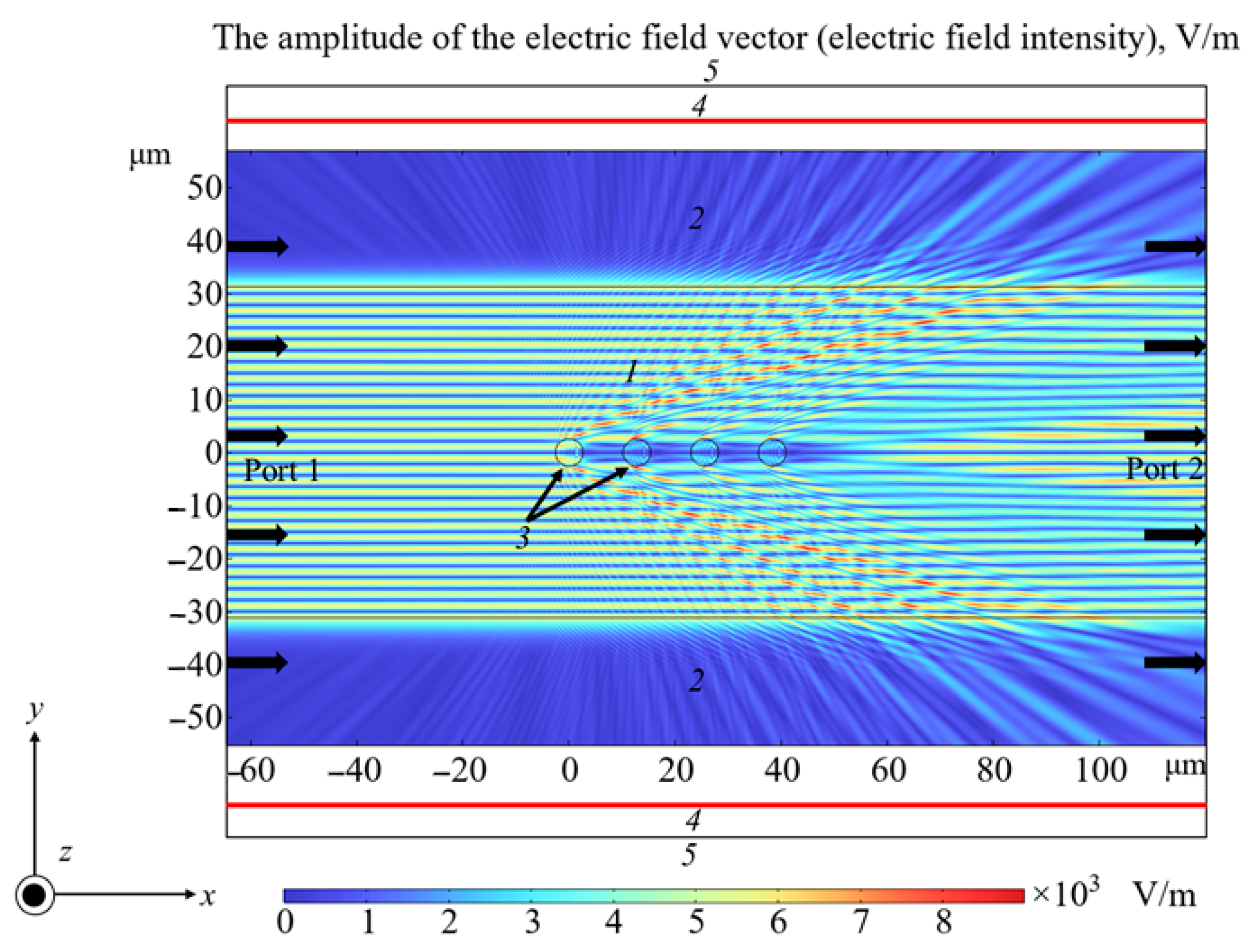
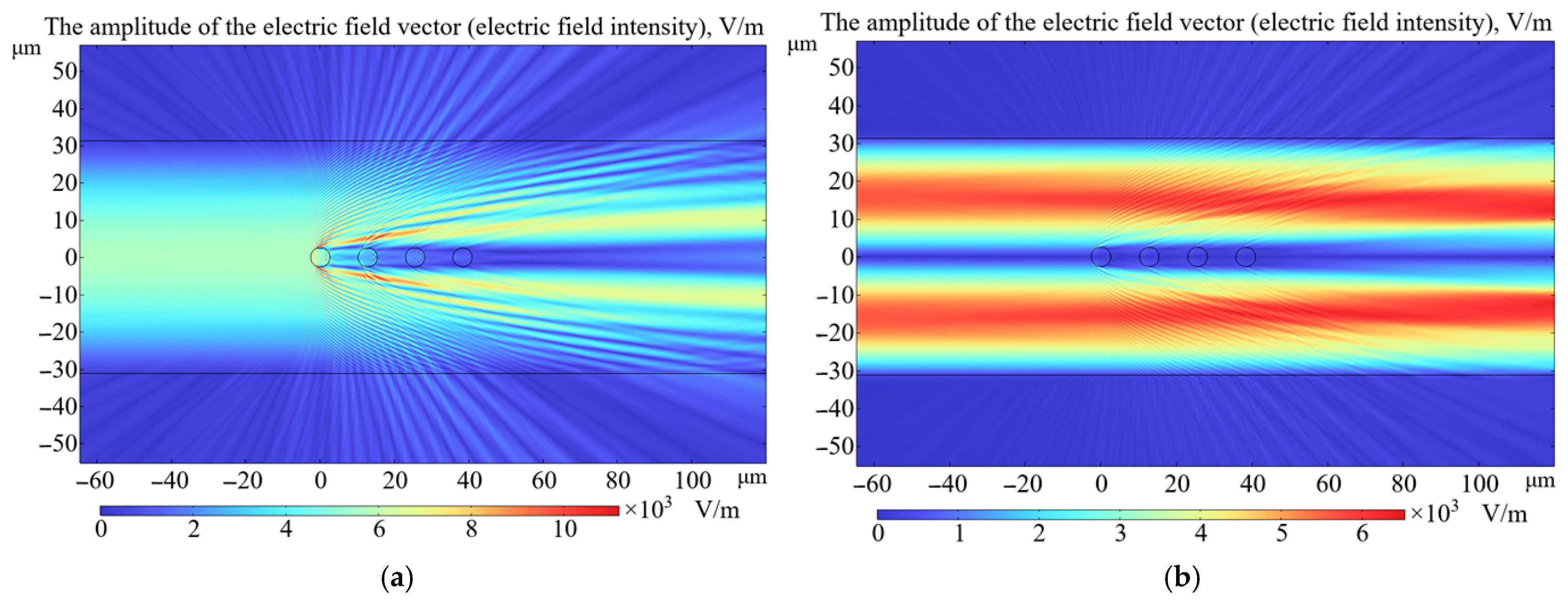
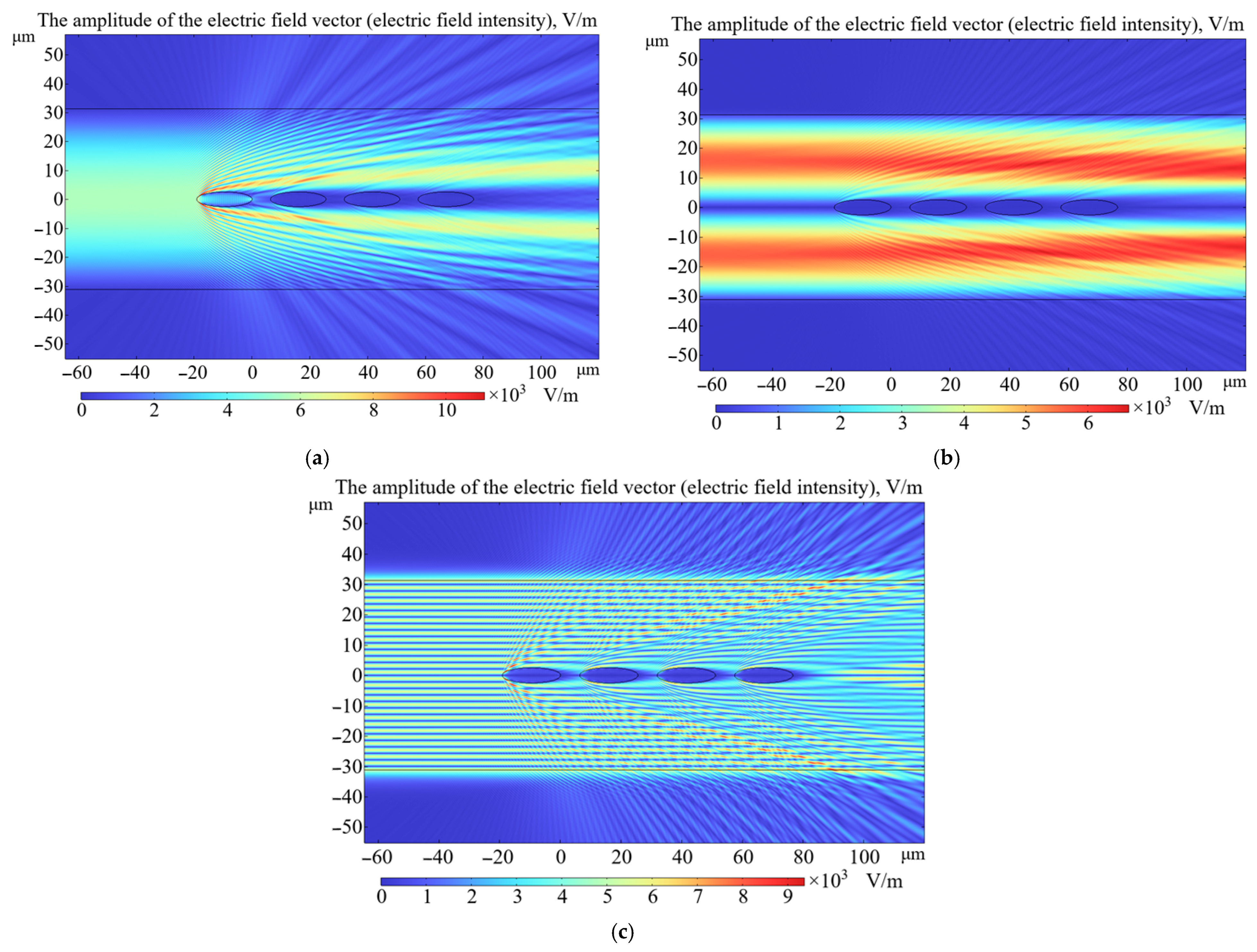

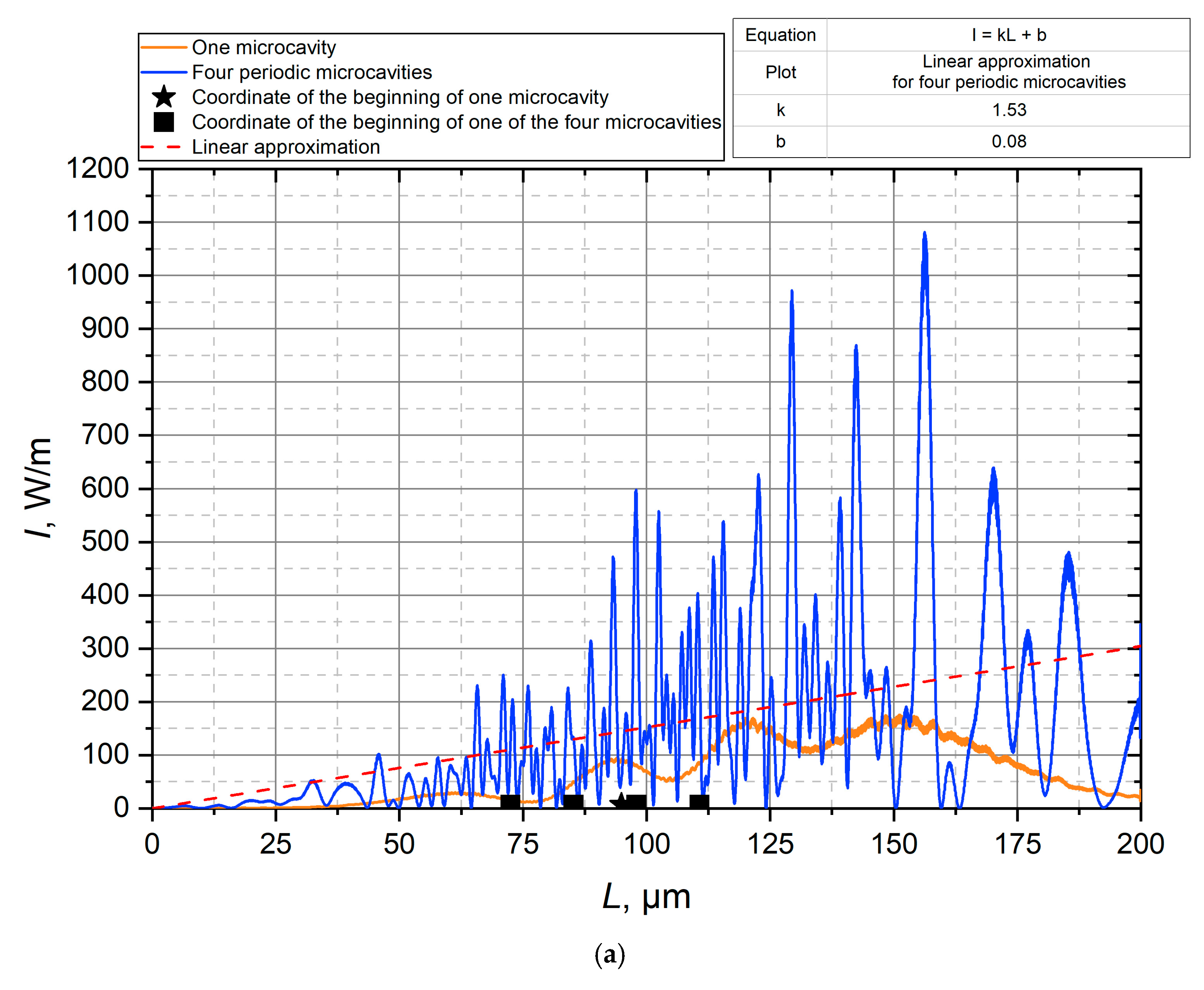
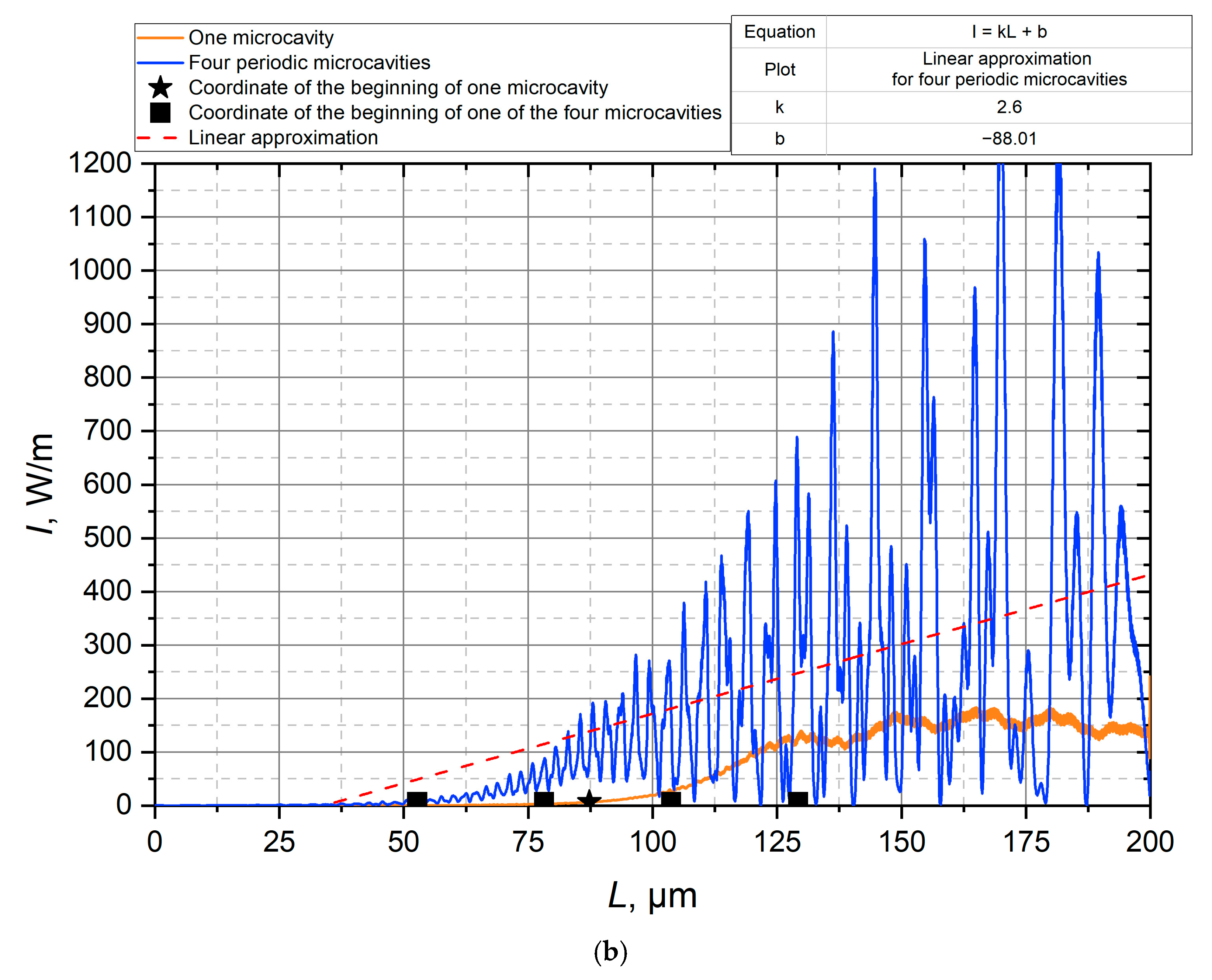
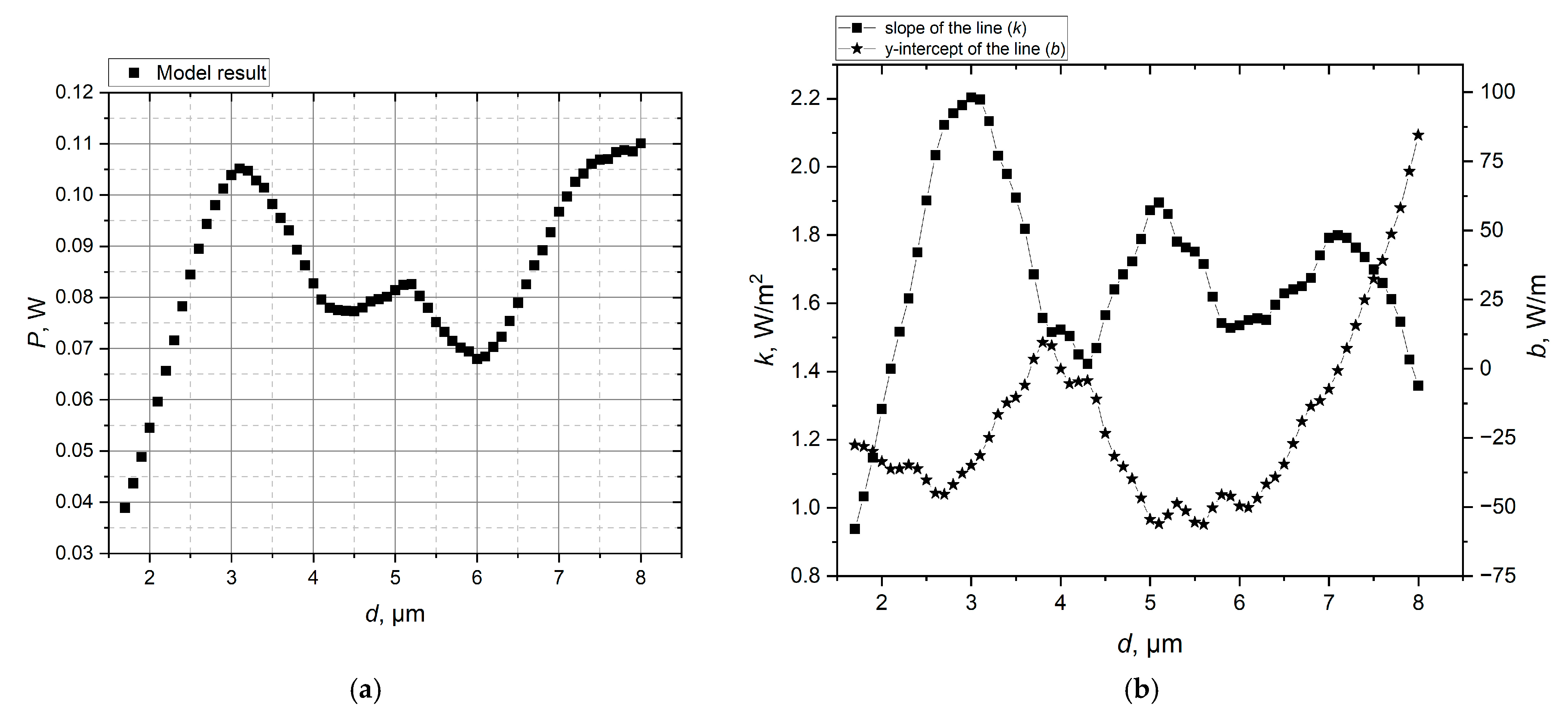
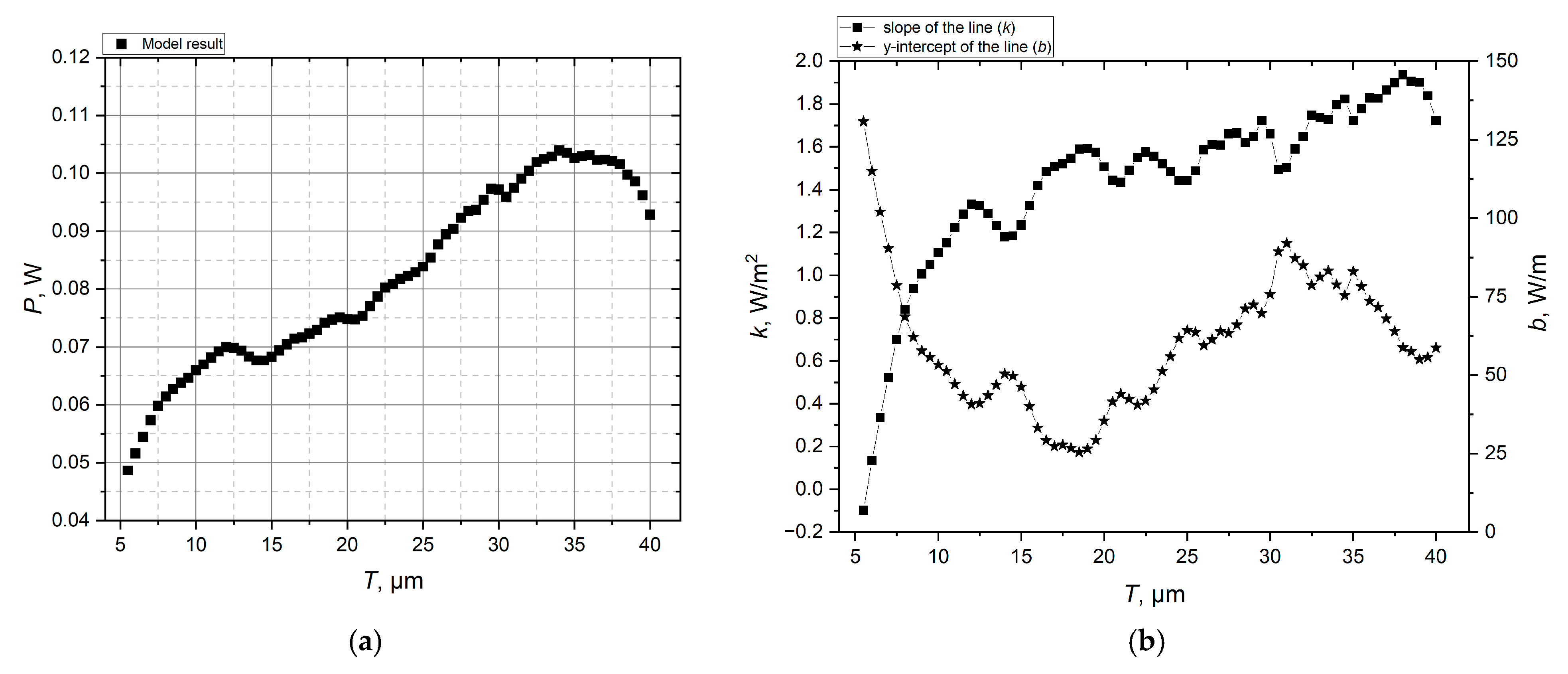



| Microcavity Shape | Length l, μm | Diameter d, μm | Periodicity T, µm | |||
|---|---|---|---|---|---|---|
| Min. | Max. | Min. | Max. | Min. | Max. | |
| Sphere | – | – | 0.86 | 3.86 | 6.38 | 38.27 |
| Ellipse | 2.20 | 11.98 | 0.86 | 5.15 | 20.41 | 38.26 |
Disclaimer/Publisher’s Note: The statements, opinions and data contained in all publications are solely those of the individual author(s) and contributor(s) and not of MDPI and/or the editor(s). MDPI and/or the editor(s) disclaim responsibility for any injury to people or property resulting from any ideas, methods, instructions or products referred to in the content. |
© 2025 by the authors. Licensee MDPI, Basel, Switzerland. This article is an open access article distributed under the terms and conditions of the Creative Commons Attribution (CC BY) license (https://creativecommons.org/licenses/by/4.0/).
Share and Cite
Petukhova, A.Y.; Perminov, A.V.; Naparin, M.A.; Krishtop, V.V. Scattering of Radiation by a Periodic Structure of Circular and Elliptical Microcavities in a Multimode Optical Waveguide. Photonics 2025, 12, 727. https://doi.org/10.3390/photonics12070727
Petukhova AY, Perminov AV, Naparin MA, Krishtop VV. Scattering of Radiation by a Periodic Structure of Circular and Elliptical Microcavities in a Multimode Optical Waveguide. Photonics. 2025; 12(7):727. https://doi.org/10.3390/photonics12070727
Chicago/Turabian StylePetukhova, Alexandra Yu., Anatolii V. Perminov, Mikhail A. Naparin, and Victor V. Krishtop. 2025. "Scattering of Radiation by a Periodic Structure of Circular and Elliptical Microcavities in a Multimode Optical Waveguide" Photonics 12, no. 7: 727. https://doi.org/10.3390/photonics12070727
APA StylePetukhova, A. Y., Perminov, A. V., Naparin, M. A., & Krishtop, V. V. (2025). Scattering of Radiation by a Periodic Structure of Circular and Elliptical Microcavities in a Multimode Optical Waveguide. Photonics, 12(7), 727. https://doi.org/10.3390/photonics12070727





